Tipi facts for kids
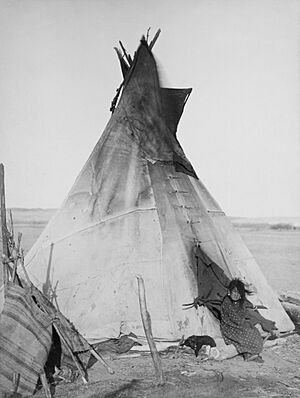
A tipi (also spelled tepee) is a cone-shaped tent used as a home by certain Indigenous peoples of the Americas. Tipis are special because they have smoke flaps at the top. This lets people have a fire inside for warmth and cooking.
For many years, tipis were made from animal skins stretched over a frame of long wooden poles. Today, they are often made with canvas. The word "tipi" comes from the Lakota and Dakota languages, spoken by tribes like the Sioux.
Tipis were mainly used by Indigenous peoples of the Great Plains and Canadian Prairies in North America. These groups included the Sioux, Blackfeet, Crow, Arapaho, and Plains Cree. Because these tribes often moved to follow herds of buffalo, the tipi was a perfect home. It could be taken down and set up again very quickly.
Today, many of these communities still use tipis, but usually for special ceremonies instead of for everyday living.
It's a common mistake to think that all Native Americans lived in tipis. Many groups from other regions lived in different kinds of homes, such as pueblos, wigwams, and longhouses.
Contents
What Makes a Tipi Special?
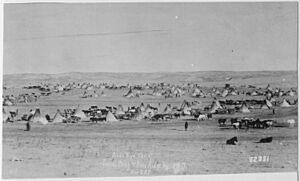
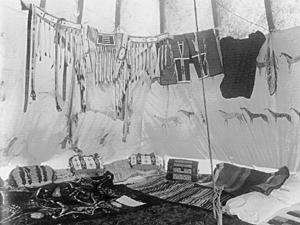
A tipi is much more than just a simple tent. Its clever design made it a comfortable and practical home.
- Durable: It could stand up to strong winds and heavy rain.
- Comfortable: It stayed warm in the winter and cool in the summer.
- Portable: It was easy to pack up and move. This was very important for tribes that were nomadic, meaning they moved from place to place.
When a tribe set up camp, the tipis were often arranged in a large circle. The door of each tipi usually faced east, toward the rising sun.
Tipi vs. Wigwam
Sometimes people confuse tipis with wigwams. A wigwam (or wickiup) is a dome-shaped home, usually covered with bark or mats. It was used by different tribes, often in wooded areas. A tipi is always a cone shape and was traditionally covered in animal hides.
How to Build a Tipi
Building a tipi requires teamwork and skill. The structure is based on a frame of long, straight poles.
The Pole Framework
The frame is made of 12 to 25 wooden poles, each about 15 to 25 feet long. Lodgepole pine was a favorite type of wood for these poles.
First, three or four main poles are tied together near the top. They are then raised and spread out to form a tripod or cone shape. The other poles are then leaned against this base to create a strong, circular frame. The poles are tied together at the top with a long rope, which is then staked to the ground in the center of the tipi to keep it stable.
The Cover
The cover was traditionally made from the hides of buffalo. It took about 10 to 20 hides, sewn together, to make one cover. Today, heavy canvas is more common.
The cover is a large, semi-circular sheet. It is wrapped around the pole frame and pulled tight. Wooden pegs are used to pin the front of the cover together, leaving an opening for a door. The bottom edge of the cover is staked to the ground.
Smart Design Features
Two key features make a tipi different from other tents:
- Smoke Flaps: At the very top of the tipi, there are two flaps of skin or canvas. These can be adjusted with long poles from the outside. By moving the flaps, people inside could control the airflow and let smoke from the central fire escape, like a chimney.
- Inner Lining: In the winter, an inner wall of hides or cloth was often hung inside the tipi. This lining created a layer of air between the inner and outer walls, which helped to keep the inside warm and dry.
Tipi Art and Stories
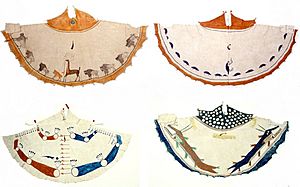
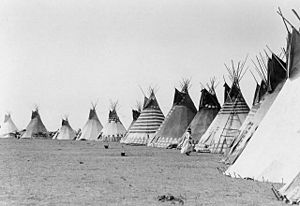
While many tipis were plain, some were decorated with beautiful paintings. These paintings were not just for looks; they often told important stories.
A painted tipi might show:
- A successful hunt or a brave deed in a battle.
- Animals, stars, or other important symbols from nature.
- A special dream or vision that the owner had.
Before a new design was painted, the owner would often hold a ceremony. Skilled artists in the tribe would then paint the story onto the tipi cover.
One famous artist was He Nupa Wanica (Joseph No Two Horns), a Lakota warrior. He painted scenes from his life and his tribe's history on tipis and animal hides. His work helps us understand the history of his people.
The Tipi's Meaning Today
The tipi is still a powerful symbol for many Indigenous cultures. It is used to teach important lessons and traditions.
For example, in some Lakota communities, young people learn to set up a tipi. Each pole they raise represents a virtue, like honesty or courage. This teaches them about their culture's values while also learning practical skills like geometry and teamwork. For the Siksika (Blackfoot) people, the tipi's shape represents their view of the world.
The tipi stands as a reminder of the history, ingenuity, and spiritual beliefs of the Indigenous peoples of the Great Plains.
Interesting Facts About Tipis
- The word tipi is a loanword. This means it came into English from the Dakota language and Lakota language.
- Modern tipis usually have a canvas covering instead of animal skins.
- In Canadian English, the spelling tipi is most common. In American English dictionaries, the spelling tepee is more common.
- The doorway of a tipi would generally face towards the rising sun.
- Tipis had special 'ears' or flaps. These could be opened and closed as needed during the summer and winter months to help with air flow.
Images for kids
-
An Oglala Lakota tipi, 1891.
-
Inside a Crow lodge from 1907. You can see the poles, outer skin, inner lining, and bedding.
-
Examples of painted tipi covers from Paul Goble’s book, Tipi: Home of the Nomadic Buffalo Hunters, 2007.
See also
 In Spanish: Tipi para niños
In Spanish: Tipi para niños
- Chum (tent), a similar structure used by various peoples from northwestern Siberia to northern Mongolia.
- Goahti, a somewhat similar structure used by the Sami people of northern Scandinavia.
- Lavvu, a conical tent covered with reindeer hides, used by the Sámi people of northern Scandinavia.
- Plains hide painting




